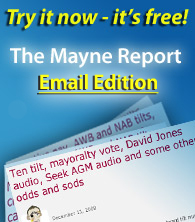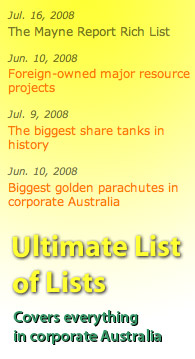Is the AGM dead?
By Stephen Mayne
November 22, 2014
This article appeared in the Chartered Secretaries Australia magazine in 2006.
Is the AGM dead? The fact that Chartered Secretaries Australia even chose to hold a symposium with that title in April is cause for concern, but is there any basis to the claim?
There is clearly deep-seated frustration amongst public company professionals about falling attendance numbers and woeful debate during the 2005 AGM season and my experiences so far in 2006 confirm that all is not well.
The recent Axa, Aristocrat, Alumina, GPT and Oxiana AGMs would have been complete non-events if I hadn't turned up and attendances numbers overall are clearly well down on previous years.
Whilst the heart of the problem is quite clearly the poor quality of questions and comments coming from retail shareholders, some legislative reform and changes in AGM procedure would go a long way to improving the level of debate.
Rather than calling for AGMs to be abandoned, there are numerous changes which might improve the system for everyone but I'd like to focus on the most important three before laying out how the perfect AGM would run.
1. The 100 shareholder rule
The requirement of 100 signatures from shareholders to get a resolution on the notice paper at an annual general meeting is too difficult. In America you only need $US2000 worth of shares. For example, the Exxon-Mobil AGM in 2003 had 12 shareholder resolutions.
Australia hasn't even had 12 different public companies that faced shareholder resolutions at AGMs over the past 15 years as this list demonstrates:
BHP: mid-1990s over Ok Tedi
James Hardie: mid-1990s over asbestos
Amcor: late 1990s over Green issues
Boral: Green resolution in 1999 supported by 6.4% of the vote
Rio Tinto: 2 union resolutions over international labour standards and independent directors in 2000 got 17% and 20% respectively
CBA: Wilderness Society on old growth logging in 2002 (23% support)
NAB: Wilderness Society on old growth logging in 2002 (21% support)
Boral: Green resolutions in 2003 (11.2%), plus 6 TWU resolutions ranging from board pay (4.3%) to safety targets (18.8%)
NAB: ASA resolution in 2004 calling for Geoff Tomlinson to be sacked with s249p statement in support that delivered 39.7% support
Bluescope Steel: Five AWU resolutions on pay and board issues in 2004 got 11-13%
CBA: Finance Sector Union resolution on restructuring in 2004 supported by s249p statement which delivered only 11.8% support.
In other words, public company boards have for too long had an effective monopoly over the resolutions up for debate at AGMs. If we want a culture of shareholder pressure in Australia we need to make it easier for shareholders to put resolutions to the vote. At the very least, it would broaden the debate.
I could have expedited the demise of director retirement schemes by several years by simply proposing resolution after resolution that they be immediately abandoned, with a compensating increase in annual fees.
Sadly, the calling of just four extraordinary general meetings by special interest groups since 1998 has cruelled the arguments for more shareholder resolutions at the AGM where there is no argument about increased cost.
These are the four EGMs cited by opponents of abolishing the 100 shareholder rule for AGMs:
Wesfarmers: 1999 EGM called by Greenies who mostly held just one
share each and got 2% support for their 8 resolutions
North Ltd: Wilderness Society EGM in 1999 with 3 resolutions supported by just 3-5% of shares voted
IAG: EGM in 2001 with resolution proposing shareholders approve director payouts. Supported by 45.8% as former chairman Whitlam was on the nose after being charged by ASIC for allegedly misusing proxies.
Gunns: Wilderness Society resolution at 2003 EGM supported by just 0.4% of shares voted
Clearly this is no epidemic, but the Federal government would be welcome to shut the gate on dubious EGMs to end this smokescreen once and for all. I would be more than happy to have a 500 signature rule and/or 10% of the issued capital requirement for EGMs because they are expensive and should be discouraged.
At the moment, the rare calling of ill-founded EGMs is being used to stifle the proper functioning of AGMs when what we need is a substantial lowering of the 100 signature barrier to shareholder resolutions at AGMs.
The government suggested a figure of 20 signatures last year but is now backing off after complaints from several corporates and, inexplicably, the Australian Shareholders' Association which came out in support of the status quo.
If $US2000 is good enough for the Americans it should be good enough for us. Besides, you only need one shareholder signature to run for a board which explains why I've run on 22 occasions since 2000. I would far prefer to put up a specific resolution for debate but simply don't have the time, contacts or resources to gather the necessary 100 signatures.
2. Make the AGM debate live
Imagine if our political leaders had their televised campaign debates after 99% of those voting had already cast their ballot. That's what happens at public company AGMs. We need to encourage more institutions to vote at AGMs after listening to the debate, rather than voting by proxy 48 hours beforehand. The Federal Government at Telstra is the only major shareholder that I'm aware that actually votes at the AGM.
One solution would be to keep proxy or direct voting open until the day after the AGM so that investors can react to any press coverage or fallout from the meeting. This would keep directors on their toes at the AGM and eliminate the “dead rubber” effect.
The chairman would feel compelled to run a good meeting if he knew shareholders could vote against his re-election the following morning if his answers weren't good enough.
Similarly, this would also be a way in which shareholders could punish companies which produce shock downgrades at AGMs and it would give all investors a chance to vote after receiving a proxy status report at the meeting. This is vital for small shareholders who often don't even realise a resolution is controversial until reading the press reports after the AGM or looking at the proxy numbers flashed up on the screen during the meeting.
I've seen debate stifled at far too many AGMs by chairs who declare the proxies before the first question is even asked. It happened on 8 May this year when Melbourne property developer Central Equity put a resolution to take the company private and Rupert Murdoch did the same when the proxies were overwhelmingly in favour of News Corp's proposed move to America in 2004.
Clearly, the proxies should only be revealed after the AGM debate is finished.
More comprehensive disclosure of shareholder voting
The Americans have moved to full public disclosure of institutional voting and we should do the same to get more fund manager accountability. This is particularly important given the growth of super and the reluctance of fund managers to attend AGMs or even publicly explain their voting behaviour. Retail shareholders feel powerless against the face of huge proxy voting numbers by unnamed institutions. If they were at least named we could then take up any grievances about voting decisions directly with the fund.The other simple reform of shareholder voting disclosure would be to publish votes based on shareholders and shares.
This is currently required on scheme of arrangement votes and the likes of Computershare already collect the data.
I completely agree that it is inappropriate for a small shareholder in BHP to have the same voting power as AMP with its $2 billion holding. Therefore, the outcomes of polls based on shareholders should not be binding, but at least it would indicate when small shareholder sentiment is different to the major shareholders.
A good example of this was the 2001 BHP shareholder vote to approve the merger with Billiton. BHP needed 75% of shares cast and got a primary vote in the proxies of 84%, which sounds reasonably comfortable.
However, a BHP insider subsequently told me that a majority of small shareholders actually voted against the merger, but these figures were never disclosed.
If companies were required to disclose the number of shareholders which vote for and against resolutions as well the total amount of shares voted, us retail shareholders would feel empowered to vote.
I've owned shares in more than 200 companies over the years and have never voted my stock unless actually attending the meeting because it is utterly meaningless when measured against the power of institutional voting. I would vote every time if the disclosure was broadened to include shareholders as well as shares.
How the perfect AGM would run
Lowering the barrier for shareholder resolutions, keeping the polls open until the day after the meeting and more fully disclosing the voting results are the big three reforms which would energise AGMs, but then there is the key question of how the actual meetings are run.
Having sat through far too many meetings neutered by long-winded presentations and raving contributions from waffling shareholders, here is an outline of how the perfect AGM would run.
Venue
Stick with the head office city or an alternative where you have a large retail shareholder base. Qantas scurrying off to Canberra last year and Rupert Murdoch getting one question in seven years from his Adelaide News Corp shareholders in the 1990s are just two of many cynical tactics employed over the years. For instance, I had a 20 minute debate with Sir Ron Brierley, chairman of Melbourne-based Premier Investments, at the 2003 AGM, so the next two AGMs were shifted to Sydney and in 2005 no shareholder bothered to turn up. This sort of evasive cynicism should stop.Time of meeting
If holding a day time meeting it must start between 10am and 2.30pm but evening AGMs should not be discounted as Lend Lease used to get large numbers at their night shows.Formal presentations
The formal presentations from the chairman and CEO should got for at least 15 minutes but no more than 40 minutes. When the Commonwealth Bank was facing a union resolution in 2004, the formal presentations were filibustered out to more than an hour, which was way too long. However, the reverse, such as James Packer's failure to deliver any address at the 1999 PBL AGM, is even more undesirable.
Get the professionals contributing to the public debate
Institutional investors and analysts should be encouraged to attend and speak at AGMs. One way to do this is by combining it with an information session or briefing for analysts and fund managers which would be of value to professional investors. Small shareholders should be able to attend this part of the day as well. News Corp had plenty of professionals attending their information meeting in Adelaide last year when there were detailed presentations on Star TV and Sky Italia.
Chairs need to be much tougher on the wafflers
The perfect AGM would go for about two hours and involve about a dozen different shareholders speaking. Too often chairs let wafflers go on for too long, when they should be shut down quickly. We need to realise that AGMs often attract lonely or eccentric people, not unlike talkback radio and political parties. No waffler lasts more than a minute on talk-back radio and chairs should take the same approach at AGMs.
Time for genuinely independent chairs or AGM moderators
If a chairman of a company can't chair a resolution debating their own election, why should be able to chair a meeting at all? The press debated the appropriateness of Graham Kraehe chairing Cathy Walter's aborted NAB EGM in 2004, but we never saw this play out. This scenario would see professional debaters, television presenters, judges, retired politicians and the like actually chairing the AGMs. For instance, they would open by laying down some ground rules and then introduce the chairman of the company to give his annual address. The professional moderator would be far more inclined to shut down wafflers early and could also rule on who should answer questions, avoiding the situation as occurred at AMP in 2003 when chairman Peter Willcox wouldn't even let directors up for election speak to the meeting.
Which directors should address the meeting
Some chairs think the AGM is their day and limit the contribution of the CEO, when it is best to maximise the number of directors actively participating. Therefore, all directors up for re-election should give a brief speech and the chairs of board committees should be available to answer specific questions from shareholders, just like the auditor is.
Disclosure of proxies
Should always be done after the debate but before the show of hands or poll, so that no-one is intimidated but everyone at the AGM is fully informed. However, if an individual shareholder such as a board candidate wishes to be advised of all the proxies before a meeting, there is no reason why they shouldn't be placed on an equal footing with the other directors facing election.Let shareholders observe any post-AGM press conference
Too often the most interesting comments at an AGM are made during the press conference afterwards. Shareholders should be invited to listen to these exchanges as Kerry Stokes does at Seven Network AGMs. That way, shareholders are not surprised by the quotes they read in the paper the next day. Journalists normally ask far better questions than retail shareholders, so at least let the shareholders listen to the exchanges.
Handling the food and beverage
A good spread will get the numbers up so make the investment and let shareholders know about it in the notice of meeting. However, throw open the food and beverages to all comers after one hour of proceedings but don't make it contingent on the AGM finishing as this often unnecessarily curtails debate. This will satisfy the free feed brigade plus those wanting to have a genuine debate.
Handling special interest groups
You can't and shouldn't stop barrow-pushers attending AGMs but one useful strategy is to give them a designated time to have their say as Boral did in 1998 when now Greens Senator Christine Milne was invited to the podium to address the meeting in exchange for Boral Green Shareholders agreeing not to ask any questions. If you know an interest group is coming, engage with them beforehand to try and hammer out some ground rules that won't see them dominate the meeting. Special interest group resolutions would have the effect of containing the debate to the one spot.
Try to maximise the attendance
An entertaining chairman, show bags for shareholders and a good spread are the three key ingredients for getting numbers up. Whilst not advocating the old Crown Casino trick of dishing out gaming vouchers, the likes of Qantas could at least offer some token assistance for shareholders wishing to fly to the AGM. The old Pacific Dunlop used to get huge numbers, partly because of the impressive shareholder showbags.
Webcast the entire AGM
News Corp is better than it's rival US media giants because Rupert Murdoch hosts a 90 minute earnings conference call with analysts each quarter which is web cast live and also left on the company's website for several weeks.
Some companies only webcast the formal addresses but these can be read through the ASX anyway. The Q&A sessions should also be webcast and available online after the event for those who couldn't make the meeting. Sure, this might disseminate illogical criticism but at least it makes the AGM more accessible for all shareholders. The likes of AMP and BHP have led the way on this.
CONCLUSION
Clearly, this is an ambitious package of legislative and functional reforms, but it would go a long way to picking AGMs off the mat. Sure, there is not going to be much debate at AGMs during these boom economic times, but we still need to ensure they are alive and kicking when they're really needed after something goes wrong.
Copyright © 2024 The Mayne Report. All rights reserved






















